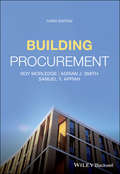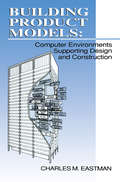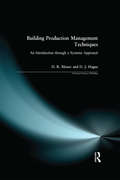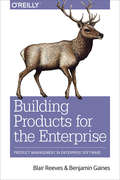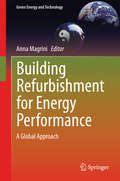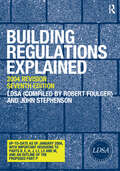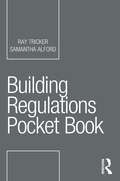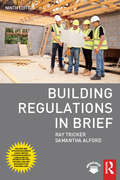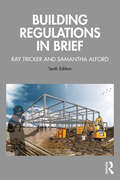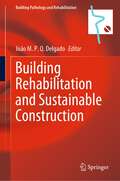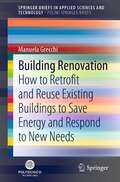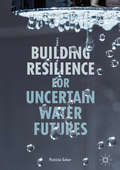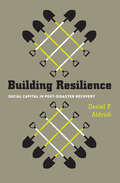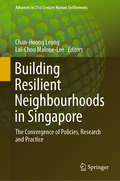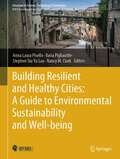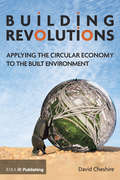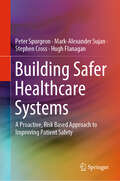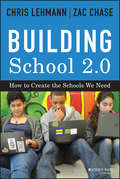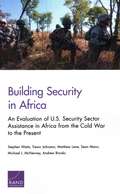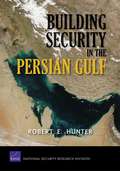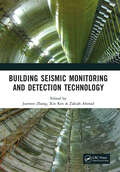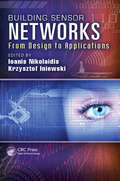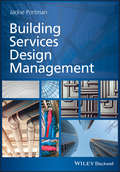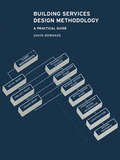- Table View
- List View
Building Procurement
by Roy Morledge Adrian J. Smith Samuel Y. AppiahAs an industrial process, construction is unique. The procurement processes used to achieve the successful completion of built assets requires a different approach to that adopted in most other industries, due to the design of buildings being bespoke and the sites being geographically varied. The procurement process is central to the success of any construction project and many of the problems which impact construction projects can be traced back to the procurement phase, so a good understanding of the methods of procurement, the development of a procurement strategy and the influence it has on project success is essential for all those working in the industry. Much has changed in the global construction industry since publication of the second edition of Building Procurement, for example the increase in debt burden of many major economies, widespread adoption of Building Information Modelling (BIM) Technology in the industry and the United Kingdom's exit from the European Union. This new edition has been rewritten to take account of these significant developments, but at its core it continues to provide a critical examination and review of current procurement practices in the UK, continental Europe (including EU procurement procedures), China, Middle East and Sub-Saharan Africa and the USA. It retains its original strong emphasis on the need for clients to establish achievable objectives which reflect the project business case and focuses on development of suitable strategies and management structures to meet those objectives in the current construction climate. Building Procurement will be essential reading for senior undergraduate and postgraduate students of construction management and practitioners working in all areas of construction management.
Building Product Models: Computer Environments, Supporting Design and Construction
by Charles M EastmanBuilding Product Models thoroughly presents the concepts, technology, and methods now used to work out what will become the building product model - a new, digital representation for architecture, civil engineering, and building construction.Organized into three sections (history, current tools and concepts, and existing efforts and research issues), this resource provides the field of building product modeling with a standard reference as well as a single, comprehensive text for university courses. Until now, all the efforts in building modeling have been reported in research journals and conference proceedings or been made available as draft standards on the Internet. Building Product Models is the only book available on this vital field, bringing together essential aspects of major efforts from the early 1970s to the present.
Building Production Management Techniques: An Introduction through a Systems Approach (Chartered Institute of Building)
by David R. Moore Douglas J. HagueBuilding Production Management Techniques provides an innovative approach to dealing with the universal problems of time, cost and quality of construction projects. The book provides an introduction to a number of management techniques that can be applied to the problems of production presented by the diverse, heavy, large and geographically distributed products typical of construction everywhere. As well as recognised and tried and tested management techniques, the authors have introduced a number of techniques which may not have been considered by the construction industry to date.
Building Products for the Enterprise: Product Management in Enterprise Software
by Blair Reeves Benjamin GainesIf you’re new to software product management or just want to learn more about it, there’s plenty of advice available—but most of it is geared toward consumer products. Creating high-quality software for the enterprise involves a much different set of challenges. In this practical book, two expert product managers provide straightforward guidance for people looking to join the thriving enterprise market.Authors Blair Reeves and Benjamin Gaines explain critical differences between enterprise and consumer products, and deliver strategies for overcoming challenges when building for the enterprise. You’ll learn how to cultivate knowledge of your organization, the products you build, and the industry you serve.Explore why:Identifying customer vs user problems is an enterprise project manager’s main challengeEffective collaboration requires in-depth knowledge of the organizationAnalyzing data is key to understanding why users buy and retain your productHaving experience in the industry you’re building products for is valuableProduct longevity depends on knowing where the industry is headed
Building Refurbishment for Energy Performance: A Global Approach (Green Energy and Technology)
by Anna MagriniIn Europe, the building sector accounts for 40% of energy consumption which has a strong influence on greenhouse gas emissions. The book deals with efficient methodologies aimed to reduce greenhouse gas emissions in the building sector. This includes analyses of the building envelopes, the heating systems, the use of solar energy and the assessment of the environmental and energy sustainability of the proposed solutions. After a brief introduction to the physical fundamentals involved in the study, results are presented to support cost-effective technical strategies to promote actions for energy saving, in the most critical fields and with the most economic advantage.
Building Regulations Explained
by John Stephenson London District Surveyors AssociationAlmost all buildings erected or altered in England and Wales must satisfy the requirements of the building regulations. This essential reference has been revised in line with new legislation up to January 2004, including important revisions to Parts B, E, H, J, L1, L2, and M and an outline of the proposed Part P.Each chapter explains in clear terms the appropriate regulation and any other legislation, before explaining the approved document. The Appeals and Determinations have been repositioned at the end of each chapter. Publications lists and relevant sources of information are also included, together with annexes devoted to legislation relevant to the construction industry, determinations made by the Secretary of State, and sample check lists.This highly illustrated and practical approach to the subject makes this the indispensable, one-stop reference guide for professionals and students.
Building Regulations Pocket Book (Routledge Pocket Books)
by Ray Tricker Samantha AlfordThis handy guide provides you with all the information you need to comply with the UK Building Regulations and Approved Documents. On site, in the van, in the office, wherever you are, this is the book you’ll refer to time and time again to double check the regulations on your current job. The Building Regulations Pocket Book is the must have reliable and portable guide to compliance with the Building Regulations. Part 1 provides an overview of the Building Act Part 2 offers a handy guide to the dos and don’ts of gaining the Local Council’s approval for Planning Permission and Building Regulations Approval Part 3 presents an overview of the requirements of the Approved Documents associated with the Building Regulations Part 4 is an easy to read explanation of the essential requirements of the Building Regulations that any architect, builder or DIYer needs to know to keep their work safe and compliant on both domestic or non-domestic jobs This book is essential reading for all building contractors and sub-contractors, site engineers, building engineers, building control officers, building surveyors, architects, construction site managers and DIYers. Homeowners will also find it useful to understand what they are responsible for when they have work done on their home (ignorance of the regulations is no defence when it comes to compliance!).
Building Regulations in Brief
by Ray Tricker Samantha AlfordThis ninth edition of the most popular and trusted guide reflects all the latest amendments to the Building Regulations, planning permission and the Approved Documents in England and Wales. This includes coverage of the new Approved Document Q on security, and a second part to Approved Document M which divides the regulations for 'dwellings' and 'buildings other than dwellings'. A new chapter has been added to incorporate these changes and to make the book more user friendly. Giving practical information throughout on how to work with (and within) the Regulations, this book enables compliance in the simplest and most cost-effective manner possible. The no-nonsense approach of Building Regulations in Brief cuts through any confusion and explains the meaning of the Regulations. Consequently, it has become a favourite for anyone in the building industry or studying, as well as those planning to have work carried out on their home.
Building Regulations in Brief
by Ray Tricker Samantha AlfordThis tenth edition of the most popular and trusted guide reflects all the latest amendments to the Building Regulations, planning permission and the Approved Documents in England and Wales. This includes coverage of the recent changes to use classes, updated sections on planning permission, permitted development and application fees. We have included the revisions to Approved Document B (as a result of the Hackitt Review), as well as the latest changes to Approved Documents F and L, and the new documents O (overheating) and S (electric vehicle charging points), which come into effect in June 2022. Giving practical information throughout on how to work with (and within) the Regulations, this book enables compliance in the simplest and most cost-effective manner possible. The no-nonsense approach of Building Regulations in Brief cuts through any confusion and explains the meaning of the Regulations. Consequently, it has become a favourite for anyone working in or studying the building industry, as well as those planning to have work carried out on their home. It is essential reading for all building contractors and subcontractors, site engineers, building engineers, building control officers, building surveyors, architects, construction site managers and DIYers.
Building Rehabilitation and Sustainable Construction (Building Pathology and Rehabilitation #23)
by João M. P. Q. DelgadoThis book provides a collection of recent research works related to building pathologies, recycled materials, case studies and practical advices on implementation of sustainable construction. It is divided in seven chapters that intend to be a resume of the current state of knowledge for benefit of professional colleagues, scientists, students, practitioners, lecturers and other interested parties to network. At the same time, these topics will be going to the encounter of a variety of scientific and engineering disciplines, such as civil, mechanical and materials engineering.
Building Renovation: How to Retrofit and Reuse Existing Buildings to Save Energy and Respond to New Needs (SpringerBriefs in Applied Sciences and Technology)
by Manuela GrecchiThis book reviews the building renovation process by systematizing the phases of analysis and prior knowledge through a project that not only considers energy savings but also thoroughly examines complex issues, such as defining the correct new functions and answers to new needs. The urgency of climate change and the many problems associated with the excessive use of energy are forcing a reorganization of the renovation process with an interest in reusing existing buildings with a more sustainable approach. The adaptive transformation of old buildings has become a dominant theme in many urban renewal projects. It must necessarily include strategies for energy efficiency, reduced pollutant emissions, improved environmental performance, economic sustainability and cultural identity. The examples selected are intended to provide evidence of good practices in the review and transformation of old buildings.
Building Resilience for Uncertain Water Futures
by Patricia GoberThis book describes the existential threats facing the global water systems from population growth and economic development, unsustainable use, environmental change, and weak and fragmented governance. It argues that ‘business-as-usual’ water science and management cannot solve global water problems because today’s water systems are increasingly complex and face uncertain future conditions. Instead, a more holistic, strategic, agile and publically engaged process of water decision making is needed.Building Resilience for Uncertain Water Futures emphasises the importance of adaptation through a series of case studies of cities, regions, and communities that have experimented with anticipatory policy-making, scenario development, and public engagement. By shifting perspective from an emphasis on management to one of adaptation, the book emphasizes the capacity to manage uncertainties, the need for cross-sector coordination, and mechanisms for engaging stakeholder with differing goals and conflict resolution. This book will be a useful resource for students and academics seeking a better understanding of sustainable water use, water policy and water resources management.
Building Resilience: Climate Change and Livelihoods in the Global South (Palgrave Studies in Climate Resilient Societies)
by Nyong Princely AwaziThis book explores the intersection of climate resilience, livelihoods, and sustainability in various sectors – from forestry to fisheries and agriculture – within the global South. The author provides a comprehensive examination of how climate change impacts these communities, the adaptive strategies they employ, and the policy frameworks necessary for promoting resilience. Through a multidisciplinary approach that integrates ecological, economic, and social dimensions, this book is an essential resource for policymakers, researchers, and practitioners in fields relating to fishery, forestry and agriculture in the global South.
Building Resilience: Social Capital in Post-Disaster Recovery
by Daniel P. AldrichThe factor that makes some communities rebound quickly from disasters while others fall apart: &“A fascinating book on an important topic.&”—E.L. Hirsch, in Choice Each year, natural disasters threaten the strength and stability of communities worldwide. Yet responses to the challenges of recovery vary greatly and in ways that aren&’t explained by the magnitude of the catastrophe or the amount of aid provided by national governments or the international community. The difference between resilience and disrepair, as Daniel P. Aldrich shows, lies in the depth of communities&’ social capital. Building Resilience highlights the critical role of social capital in the ability of a community to withstand disaster and rebuild both the infrastructure and the ties that are at the foundation of any community. Aldrich examines the post-disaster responses of four distinct communities—Tokyo following the 1923 earthquake, Kobe after the 1995 earthquake, Tamil Nadu after the 2004 Indian Ocean Tsunami, and New Orleans post-Katrina—and finds that those with robust social networks were better able to coordinate recovery. In addition to quickly disseminating information and financial and physical assistance, communities with an abundance of social capital were able to minimize the migration of people and valuable resources out of the area. With governments increasingly overstretched and natural disasters likely to increase in frequency and intensity, a thorough understanding of what contributes to efficient reconstruction is more important than ever. Building Resilience underscores a critical component of an effective response.
Building Resilient Neighbourhoods in Singapore: The Convergence of Policies, Research and Practice (Advances in 21st Century Human Settlements)
by Chan-Hoong Leong Lai-Choo Malone-LeeThis book examines how institutional and environmental features in neighbourhoods can contribute to social resilience, highlighting the related socio-demographic issues, as well as the infrastructure, planning, design and policies issues. It is divided into three themes – infrastructure, planning, and community. Infrastructure examines how physical features such as parks and street patterns influence neighborliness and resilience, while planning studies how urban design enhances social interactions. Lastly, community discusses policies that can forge social bonds, either through racial integration, grassroots activities, or social service. Overall, the book combines research and empirical work with scholarly models of resilience and governance philosophy, focusing on Singapore’s urban planning and social policies.
Building Resilient and Healthy Cities: A Guide to Environmental Sustainability and Well-being (Advances in Science, Technology & Innovation)
by Anna Laura Pisello Stephen Siu Yu Lau Ilaria Pigliautile Nancy M. ClarkThis book presents a number of research papers that discuss how green urbanism is connected to promoting healthier living conditions. This is to reduce the impact of environmental changes including climate change, depletion of the earth's resources, and the emergence of infectious diseases and pandemics on humans. Addressing these challenges, the book at hand offers strategies and solutions that enable designers to bring together knowledge about sustainable and comfortable urban built environments, with an emphasis on the correlation between architecture, engineering, and medical facets in regard to comfort and well-being. Thus, the book is of significant importance to architects interested in the science of the built environment, climate change, and human resilience. This book is a culmination of selected research papers from the first version of the international conference on "Health & Environmental Resilience and Livability in Cities (HERL) - The challenge of climate change" which was held online in 2022 in collaboration with the University of Perugia, Italy, and the fifth edition of the international conference on Green Urbanism (GU) which was held online in 2021 in collaboration with the University of Rome.
Building Revolutions: Applying the Circular Economy to the Built Environment
by David CheshireThe construction industry operates within a linear economy of make, use, dispose. Buildings are stripped out and torn down with astonishing regularity while new buildings are constructed from hard-won virgin materials. But raw materials are becoming scarce, and the demands for them are exploiting fragile ecosystems, even as the global demand for resources continues to rise. Policy makers and organisations are beginning to look for a more regenerative, circular economy model. The construction industry demands over half the world’s extracted materials and generates around a third of the total waste generated in the EU, making it a prime candidate for applying the circular economy. Yet there has been little focus on how construction industry professionals and their clients can contribute towards the movement. Drawing on illustrative methods and examples, Building Revolutions explains how the principles of a circular economy can be applied to the built environment where resources are kept in use and their value retained.
Building Safer Healthcare Systems: A Proactive, Risk Based Approach to Improving Patient Safety
by Peter Spurgeon Mark-Alexander Sujan Stephen Cross Hugh FlanaganThis book offers a new, practical approach to healthcare reform. Departing from the priorities applied in traditional approaches, it instead assesses – both theoretically and practically – the successful lessons learned in other safety-critical industries, and applies them to healthcare settings. The authors focus on the importance of human factors and performance measures to establish proactive, systematic methods for healthcare system design. This approach helps to identify potential hazards before accidents occur, enhancing patient safety. In addition, the book details the new approach on the basis of real-world applications in the NHS and insights from NHS staff. Case studies and results are presented, demonstrating the significant improvements that can be achieved in risk reduction and safety culture. Lastly, the book outlines what steps healthcare organisations need to take in order to successfully adopt this new approach. The approach and experiential learning is brought together through the development of a new holistic patient safety education syllabus.
Building School 2.0
by Chris Lehmann Zac ChaseNinety-five propositions for creating more relevant, more caring schools There is a growing desire to reexamine education and learning. Educators use the phrase "school 2.0" to think about what schools will look like in the future. Moving beyond a basic examination of using technology for classroom instruction, Building School 2.0: How to Create the Schools We Need is a larger discussion of how education, learning, and our physical school spaces can--and should--change because of the changing nature of our lives brought on by these technologies. Well known for their work in creating Science Leadership Academy (SLA), a technology-rich, collaborative, learner-centric school in Philadelphia, founding principal Chris Lehmann and former SLA teacher Zac Chase are uniquely qualified to write about changing how we educate. The best strategies, they contend, enable networked learning that allows research, creativity, communication, and collaboration to help prepare students to be functional citizens within a modern society. Their model includes discussions of the following key concepts: Technology must be ubiquitous, necessary, and invisible Classrooms must be learner-centric and use backwards design principles Good technology can be better than new technology Teachers must serve as mentors and bring real-world experiences to students Each section of Building School 2.0 presents a thesis designed to help educators and administrators to examine specific practices in their schools, and to then take their conclusions from theory to practice. Collectively, the theses represent a new vision of school, built off of the best of what has come before us, but with an eye toward a future we cannot fully imagine.
Building Security in Africa: An Evaluation of U.S. Security Sector Assistance in Africa from the Cold War to the Present
by Stephen Watts; Trevor Johnston; Matthew Lane; Sean Mann; Michael J. McNerney; Andrew Brooks;A RAND Corporation study used statistical models to evaluate the impact that U.S.-provided SSA has had on political violence in Africa--in particular, the incidence of civil wars and insurgencies, terrorist attacks, and state repression.
Building Security in the Persian Gulf
by Robert E. HunterThe United States must determine how best to promote long-term security and stability in the Persian Gulf region while seeking to reduce the risks and costs imposed by its role as a permanent regional power. The author analyzes Iraq's future, the role of Iran, asymmetric threats, regional reassurance, regional tensions, and the roles of other external actors. He then sets out criteria and requirements for a new regional security structure.
Building Seismic Monitoring and Detection Technology: Proceedings of the 2nd International Conference on Structural Seismic Resistance, Monitoring and Detection (SSRMD 2023), Xiamen, China, 6-8 January 2023
by Xin Ren Zakiah Ahmad Junwen ZhangBuilding Seismic Monitoring and Detection Technology focuses on the research of seismic resistance and monitoring technology. The book gathers cutting-edge research and achievements, and includes contributions on the following subjects: New concepts and key technologies of structural regulation and disaster prevention Test and monitoring study of thermal insulation in tunnels Protection of steel and concrete structures using arc thermal spray Research progress of mechanical metamaterials This book is aiming at scholars and engineers involved or interested in structural engineering and seismic detection technology.
Building Sensor Networks: From Design to Applications (Devices, Circuits, and Systems #17)
by Krzysztof Iniewski Ioanis NikolaidisFor all the interest that wireless sensor networks have created over the past decade, there are few examples to show that they are truly delivering on this promise and anticipation. What is missing? Deviating from the usual focus on routing and energy efficiency, Building Sensor Networks: From Design to Applications attempts to stitch together the path from conceptual development of applications, on one end, to actual complete applications at the other. With this change in perspective, the book examines important facets of wireless sensor networks (WSNs) that are not often discussed in the literature. From Design Practices to the Networking Protocols that Glue Applications Together Organized into three sections, the book presents insights from international experts representing both industry and academia. The first section, on design practices, explores alternative ways to approach the tasks of developing a suitable WSN solution to an application and assisting that development in a manner that is not necessarily tied to a particular application. The second section, on networking protocols, illustrates the impact of the intermediaries—the "glue" of putting applications together. Chapters look at ways to address traffic, delays in network clustering, and the coexistence of a WSN with other systems on a frequency band. The final section of the book delves into experiences with applications in chemical sensing, defense, global trade and security, and ecosystem monitoring. Although these applications may fail the purist definition of an ideal WSN, they offer valuable lessons for the future development and deployment of WSNs. Challenge Your Thinking about Designing WSN Applications Emphasizing the need to build applications, the contributors present examples of what applications of WSNs could look like and identify the constraints. Throughout, the book challenges and illuminates your thinking about how to tame the complexity of designing a WSN application. It is essential reading for anyone interested in future wireless technologies.
Building Services Design Management
by Jackie PortmanBuilding services refers to the equipment and systems that contribute to controlling the internal environment to make it safe and comfortable to occupy. They also support the requirements of processes and business functions within buildings, for example manufacturing and assembly operations, medical procedures, warehousing and storage of materials, chemical processing, housing livestock, plant cultivation, etc. For both people and processes the ability of the building services engineering systems to continually perform properly, reliably, effectively and efficiently is of vital importance to the operational requirements of a building. Typically the building services installation is worth 30-60% of the total value of a contract, however existing publications on design management bundles building services engineering up with other disciplines and does not recognise its unique features and idiosyncrasies. Building Services Design Management provides authoritative guidance for building services engineers responsible for the design of services, overseeing the installation, and witnessing the testing and commissioning of these systems. The design stage requires technical skills to ensure that the systems are safe, compliant with legislative requirements and good practices, are cost-effective and are coordinated with the needs of the other design and construction team professionals. Covering everything from occupant subjectivity and end-user behaviour to design life maintainability, sequencing and design responsibility the book will meet the needs of building services engineering undergraduates and postgraduates as well as being an ideal handbook for building services engineers moving into design management.
Building Services Design Methodology: A Practical Guide
by David Bownass D. BownassBuilding Services Design Methodology clearly sets out and defines the building services design process from concept to post-construction phase. By providing a step-by-step methodology for students and practitioners of service engineering, the book will encourage improved efficiency (both in environmental terms and in terms of profit enhancement) through better project management. Generic advice and guidance is set in the current legal and contractual context, ensuring that this will be required reading for professionals. The book's practical style is reinforced by a number of case studies.
